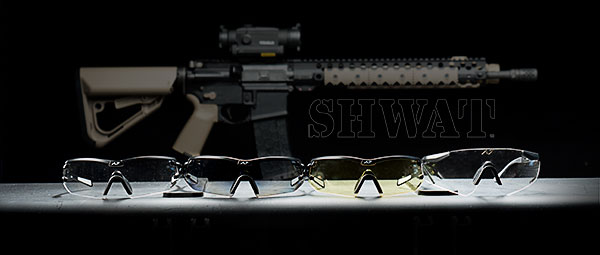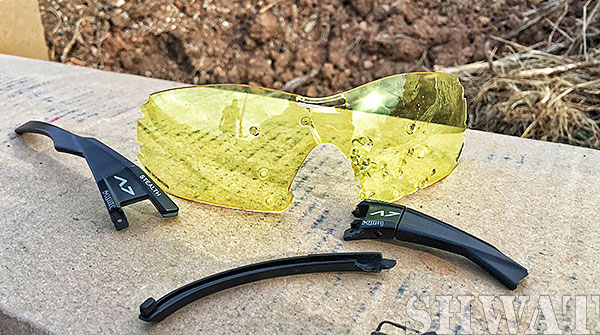Scientists are chasing the concept of bionic eyes, but in reality the idea remains much more in the realm of science fiction. So in the here and now, hunters and shooters need eye protection. As a guy forever grateful for Lasik surgery, I’ll chase a promising eye pro story anytime. With that in mind – and a hat tip to Dick Cheney – I sent some 12 gauge steel shot to investigate the Angel 7 (A7) Apollo and Stealth models.

Never heard of Angel 7? Neither had I, but the head of the brain trust there has a pretty remarkable story. One biographer compared him to Tony Stark, Marvel’s Iron Man inventor/genius/mad scientist. Kerry Harris was an enlisted sailor, a Marine Corps officer, and a Naval Aviator. He did some innovative things with motorcycle helmets and has more recently worked on military aviation helmet systems.
One thing led to another and Harris ends up developing a one of a kind eye protection system called i-RMR (“eye-armor”). With a lens thickness essentially the same as other eye pro in my collection, it basically provides the same protection to your eyes that Level 1 body armor provides to your torso. “No way!” you say? Well, here’s the gear geek version of that:
The test results showed that i-RMR lenses achieved a V0 of greater than 1000 feet per second and a V50 of almost 950 feet per second! To put those numbers in perspective, level I body armor protects from ballistic impacts at a velocity of 1050 feet per second + or – 30 according to the National Institute of Justice Ratings for Body Armor (NIJ).Granted, Level 1 body armor is probably isn’t good protection against more than .22 Long Rifle or .38 Special projectiles, but if you have those or anything bigger coming your way you have other more pressing issues to deal with. I-RMR lenses meet US MIL-DTL-43511D ANSI Z87.1 and are EN 166 Compliant.

The Angel 7 eye pro collection has three patents and two more pending. In addition to the ballistic protection, i-RMR lenses get optional functions like transition type lenses, mirror properties and tints without the traditional hand sprayed coating process. Instead, through automation multiple materials go into the injection molding machine that creates the lenses. The consistency of this process virtually eliminates any quality control rejections creating cost savings.
We all like saving money, but here’s a bigger benefit: Without a traditional surface coating, issues of scratching and wear are mitigated. If you’re into mirrored lenses, you know that typically the mirror finish will eventually wear off. Not so with the A7 i-RMR technology. A proprietary “Chrysalis” coating that causes water to bead and consequently run off the lens is bonded to the outer layer. I tested this out and it works as advertised.
The obvious questions now revolve around weight, clarity and style and the 12 gauge I mentioned.
The Angel 7 Apollo and Stealth are both lightweight on my face, comparable to everything similar I’ve tried. The full coverage Apollo weighs in at 34 grams and the Stealth at 31.
Clarity is fantastic. Not much else to say about that. You’ll probably forget you’re wearing the eye pro.
Style? Honestly they are not as refined as brands that have been around for a while. And despite what my brothers might say about their sibling having a big head, I have a smaller than average hat size. The A7 Stealth and Apollo models are big on me. Not so big I wouldn’t use them, but smaller would definitely be better. Harris tells me such things are in the works already.
Now, about the 12 gauge test. Harris posted a video where he shot a pair of Apollos at fifteen feet with steel shot. I figured I should duplicate that test in the name of due diligence. And in the name of fun I substituted a watermelon for the manikin head Harris used!

I bought a box of Winchester Super X #6 1-1/8 oz. shot steel shot, 2-3/4″ length, 1,280 fps velocity. I put the watermelon on a stake, measured off fifteen feet, melon to muzzle and pulled the trigger on my twenty-six inch barreled modified choke Remington 1100. I got wet, my cameras got wet, and I didn’t have a spotter to see where the Angel 7 Apollo eye pro went. They are lost in some thick weeds I guess. Bummer, but I have to say shooting watermelons with a 12 gauge should be a sport!
Not to be deterred, I secured an A7 Stealth pair with a yellow “high definition” tint to a cardboard box and blasted them. The results verified Harris’s work, though I’d like to redo the whole thing with water melons using slow motion video. As you can see, only one pellet that caught the lens edge did anything besides dent it. A critical inspection leads me think that two pellets hit the same spot, with the second one creating the nick. Part of this guess is based on an edge hit on the opposite side of the lens that did not come close to penetrating or braking the lens material.

Models can be had in clear, polarized tactical (polarized, but you can still read an LCD screen on your phone or camera), high definition (yellow tint), mirrored photochromic (low light usable lens that transforms into a fully mirrored lens when exposed to direct sunlight), laser eye protection and “Ghost Shield” which functions like transitions. You can even combinations like mirrored polarized. Between the time I sat down to write this and the time I click publish, Angel 7 could have introduced two new options. They have a lot going on. Universal prescription carriers (UPC) are available for both the Apollo and Stealth series. Prices start at $75 and top out at $250 with laser protection.
I don’t often get the chance to flat out destroy stuff for the sake of a review, but when I saw the Angel 7 video, I had to give it a shot. Literally. You can find other good, even great eye protection on the market. Even Harris will tell you that, and he’s pretty proud of his A7 line. I respect his candor and believe his confidence in his A7 eye pro line is well placed. If your priority is simply the utmost in eye protection, I believe we have a winner with Angel 7.



